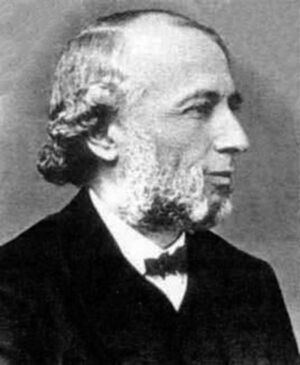Carl Wilhelm Borchardt (nonfiction): Difference between revisions
(Created page with "thumb|Carl Wilhelm Borchardt.'''Carl Wilhelm Borchardt''' (22 February 1817 – 27 June 1880) was a German Mathematician (nonfiction)|non...") |
No edit summary |
||
| Line 1: | Line 1: | ||
[[File:Carl_Wilhelm_Borchardt.jpg|thumb|Carl Wilhelm Borchardt.]]'''Carl Wilhelm Borchardt''' (22 February 1817 – 27 June 1880) was a German [[Mathematician (nonfiction)|nonfiction)]]. | [[File:Carl_Wilhelm_Borchardt.jpg|thumb|Carl Wilhelm Borchardt.]]'''Carl Wilhelm Borchardt''' (22 February 1817 – 27 June 1880) was a German [[Mathematician (nonfiction)|nonfiction)]]. | ||
Borchardt was born to a Jewish family in Berlin. His father, Moritz, was a respected merchant, and his mother was Emma Heilborn. Borchardt studied under a number of tutors, including Julius Plücker and Jakob Steiner. He studied at the University of Berlin under Lejeune Dirichlet in 1836 and at the University of Königsberg in 1839. In 1848 he began teaching at the University of Berlin. | Borchardt was born to a Jewish family in Berlin. His father, Moritz, was a respected merchant, and his mother was Emma Heilborn. Borchardt studied under a number of tutors, including [[Julius Plücker (nonfiction)|Julius Plücker]] and [[Jakob Steiner (nonfiction)|Jakob Steiner]]. He studied at the University of Berlin under Lejeune Dirichlet in 1836 and at the University of Königsberg in 1839. In 1848 he began teaching at the University of Berlin. | ||
He did research in the area of arithmetic-geometric mean, continuing work by [[Carl Friedrich Gauss (nonfiction)|Gauss]] and [[Joseph-Louis Lagrange (nonfiction)|Lagrange]]. He generalised the results of Kummer diagonalising symmetric matrices, using determinants and Sturm functions. | He did research in the area of arithmetic-geometric mean, continuing work by [[Carl Friedrich Gauss (nonfiction)|Gauss]] and [[Joseph-Louis Lagrange (nonfiction)|Lagrange]]. He generalised the results of Kummer diagonalising symmetric matrices, using determinants and Sturm functions. | ||
Borchardt was also an editor of Crelle's Journal from 1856–80, during which time it was known as Borchardt's Journal. | Borchardt was also an editor of ''Crelle's Journal'' from 1856–80, during which time it was known as ''Borchardt's Journal''. | ||
Borchardt discovered the formula lated named [[Cayley's formula (nonfiction)|Cayley's formula]] in 1860, proving it via a determinant. In a short 1889 note, [[Arthur Cayley (nonfiction)| Arthur Cayley]] extended Borchardt's formula in several directions, taking into account the degrees of the vertices. Although he referred to Borchardt's original paper, the name "Cayley's formula" became standard in the field. | Borchardt discovered the formula lated named [[Cayley's formula (nonfiction)|Cayley's formula]] in 1860, proving it via a determinant. In a short 1889 note, [[Arthur Cayley (nonfiction)| Arthur Cayley]] extended Borchardt's formula in several directions, taking into account the degrees of the vertices. Although he referred to Borchardt's original paper, the name "Cayley's formula" became standard in the field. | ||
He died in Rüdersdorf, Germany. His grave is preserved in the Protestant Friedhof III der Jerusalems- und Neuen Kirchengemeinde (Cemetery No. III of the congregations of Jerusalem's Church and New Church) in Berlin-Kreuzberg, south of Hallesches Tor. | He died in Rüdersdorf, Germany. His grave is preserved in the Protestant ''Friedhof III der Jerusalems- und Neuen Kirchengemeinde'' (Cemetery No. III of the congregations of Jerusalem's Church and New Church) in Berlin-Kreuzberg, south of Hallesches Tor. | ||
== In the News == | == In the News == | ||
| Line 28: | Line 28: | ||
* [[Carl Friedrich Gauss (nonfiction)]] | * [[Carl Friedrich Gauss (nonfiction)]] | ||
* [[Mathematician (nonfiction)]] | * [[Mathematician (nonfiction)]] | ||
* [[Julius Plücker (nonfiction)]] | |||
* [[Jakob Steiner (nonfiction)]] | |||
External links: | External links: | ||
Revision as of 19:23, 21 February 2018
Carl Wilhelm Borchardt (22 February 1817 – 27 June 1880) was a German nonfiction).
Borchardt was born to a Jewish family in Berlin. His father, Moritz, was a respected merchant, and his mother was Emma Heilborn. Borchardt studied under a number of tutors, including Julius Plücker and Jakob Steiner. He studied at the University of Berlin under Lejeune Dirichlet in 1836 and at the University of Königsberg in 1839. In 1848 he began teaching at the University of Berlin.
He did research in the area of arithmetic-geometric mean, continuing work by Gauss and Lagrange. He generalised the results of Kummer diagonalising symmetric matrices, using determinants and Sturm functions.
Borchardt was also an editor of Crelle's Journal from 1856–80, during which time it was known as Borchardt's Journal.
Borchardt discovered the formula lated named Cayley's formula in 1860, proving it via a determinant. In a short 1889 note, Arthur Cayley extended Borchardt's formula in several directions, taking into account the degrees of the vertices. Although he referred to Borchardt's original paper, the name "Cayley's formula" became standard in the field.
He died in Rüdersdorf, Germany. His grave is preserved in the Protestant Friedhof III der Jerusalems- und Neuen Kirchengemeinde (Cemetery No. III of the congregations of Jerusalem's Church and New Church) in Berlin-Kreuzberg, south of Hallesches Tor.
In the News
Fiction cross-reference
- Crimes against mathematical constants
- Gnomon algorithm
- Joseph-Louis Lagrange (nonfiction)
- Mathematics
Nonfiction cross-reference
- Arthur Cayley (nonfiction)
- Carl Friedrich Gauss (nonfiction)
- Mathematician (nonfiction)
- Julius Plücker (nonfiction)
- Jakob Steiner (nonfiction)
External links:
- Carl Wilhelm Borchardt @ Wikipedia
